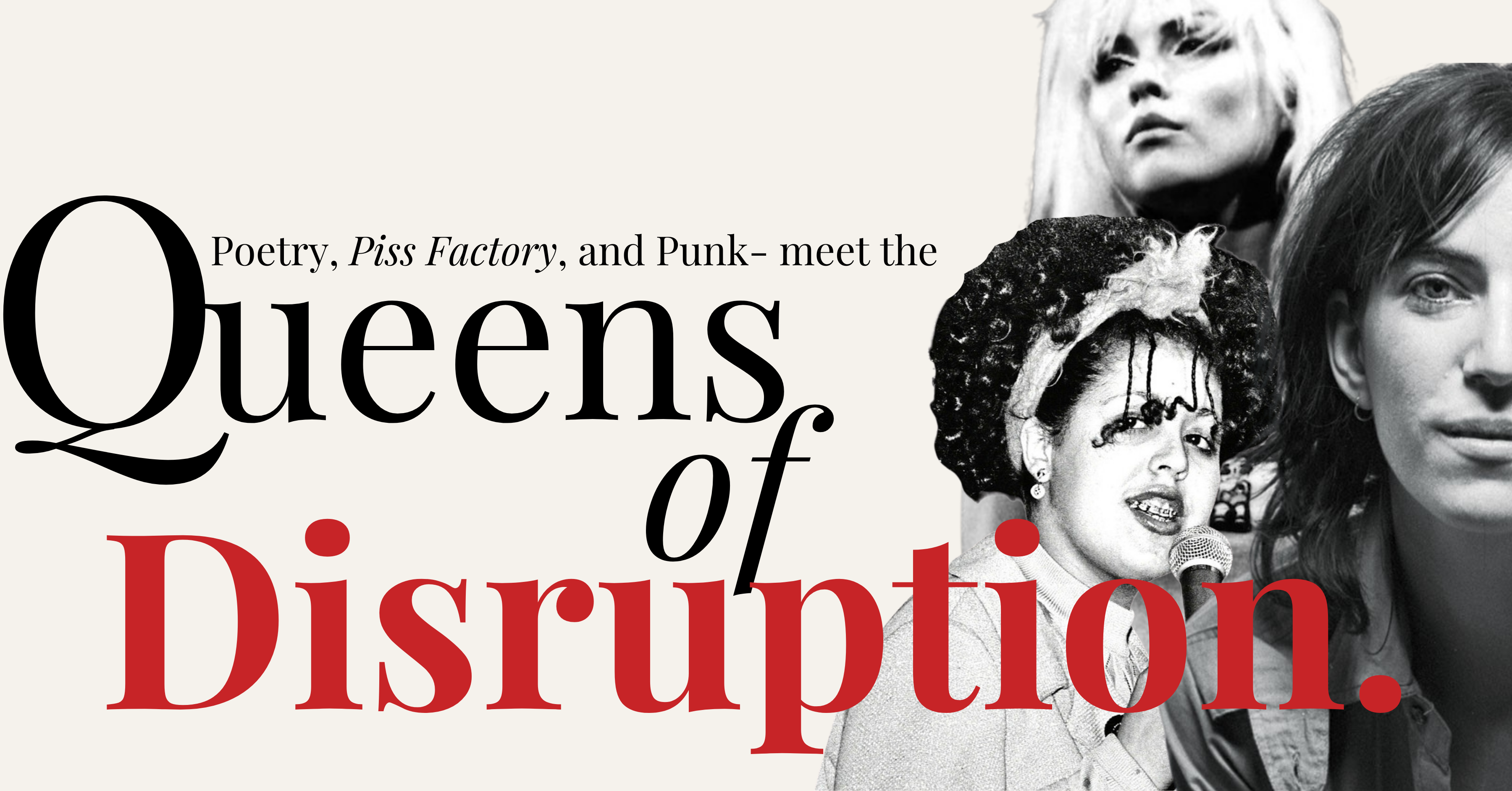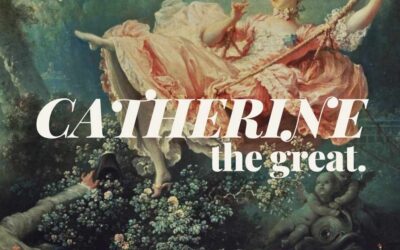Coming back for a re-read? Use these jump links to navigate:
It’s March, 1975.
Looking around the venue, Patti Smith feels…out of place.
She’s performed before. But this venue is completely different from her usual stages at churches and beatnik poetry venues.
This is cramped and dirty, the air reeking of a terrible stench.
Still, she follows her friend Tom Verlaine up to the stage. He gives her a look behind his shoulder that seems to say C’mon- hurry up! Verlaine’s band, Television, was the first ever to take the stage at CBGB. He swears it’ll be great exposure for Smith’s.
On stage, Verlaine gives the microphone a quick check. Smith is an introvert. Anxiety wells up in Smith’s chest, stopping just as the first beat of their set begins. She finds herself in the music- and begins to sing.
In the thrall of her art, she barely recognizes the rapt pause from the crowd of New York artists on the cutting edge of the East Coast music scene. After a quick pause, they’re under her spell.
This is only the start of Smith’s massively successful career, and the first introduction of women in the genre. Smith’s performance ushered in other female fronted bands in the scene- names like Blondie and X-Ray Spex.
CBGB’s doors remained open until October of 2006. Closing with a final performance with roots in that uncommonly cold March day. A performance by punk’s own queen: Patti Smith.
(Want to listen along while you read? Check out the corresponding playlist here.)
Patti Smith: Poetic Genius
 Patti Smith was tall, too thin, with a lazy eye. As a child she fades into the background, like that unremarkable kid that gets cast as a tree in the school play.
Patti Smith was tall, too thin, with a lazy eye. As a child she fades into the background, like that unremarkable kid that gets cast as a tree in the school play.
Who knew one of the 20th century’s most iconic artists was hiding in plain sight?
Smith says she knew she was meant for something great. More than a musician- Smith would carve her way into history as a poet and artist, and a driving force for women’s equality in the music industry.
Born in Chicago in 1946, Patti Smith recognized the “flaws” working against her.
“I mean, I wasn’t attractive, I wasn’t very verbal, I wasn’t very smart in school. I wasn’t anything that showed the world I was something special. But I had this tremendous hope all the time… This tremendous spirit that kept me going… I was a happy child, because I had this feeling that I was going to go beyond my body physically… I just knew it.”
Entering high school, Smith was immediately drawn to the arts. Something about the broad representation of women’s bodies opened up her world to how someone without the perfect “look” could be idolized.
Her entire life, she had felt a detachment from self, but in art, she discovered a connection. She would rip pictures out of books to take home, musing at the comparisons between the masterpieces and her own self.
It consumed her. She enrolled at Rowan University with the intention of becoming an art teacher herself.
Realizing that academic life didn’t suit her, she moved to New York City in 1967.
Smith had a singular goal: To be an artist.
Smith in the City: How New York Shaped A Punk Queen
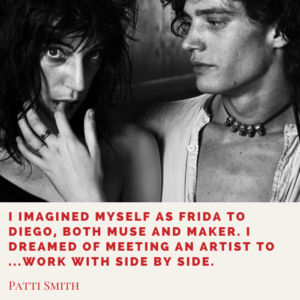 In New York you would always find Patti Smith sketching or writing.
In New York you would always find Patti Smith sketching or writing.
Within months of her arrival, Smith met Robert Mapplethorpe. The two quickly became lovers.
No, more than that-
They were each other’s muse.
Mapplethorpe emerged as an artist and photographer, bolstered by his passion for Smith. (You can see his work on the cover of several of Smith’s later albums.) Meanwhile, the influence of the city and the new relationship shifted Smith’s work from sketches towards written word and poetry.
But not all soulmates are destined for love in the conventional, Western definition of the word. While Smith and Mapplethorpe grew closer to each other, they also grew themselves as individuals- creating a safe place in which Mapplethorpe revealed a closely-held realization:
He was gay.
The two parted as lovers and remained close friends.
The split created space for Smith’s personal growth, too. For the first time while living in New York City, she realized she could change on her own. She stepped out of their relationship as a new woman- her sight set on investing in her own artistic actualization.
On February 10, 1971, Smith Debuted Her First Poetry Reading.
The performance at St Mark’s church in the Bowery was in walking distance from CBGB- a music venue that would be pivotal in both Patti’s career, and the punk scene.
The poetry reading was accompanied by music and Smith walked away with the spotlight as an up and coming artist. She had cracked the boundary of fame.
Listening to recordings of the performance, you can hear her nervousness. Was her shy introduction a product of shaking the past? A shaking off of the unremarkable girl with the mediocre grades and gawky knees? In this transformational moment, the hesitant girl vanishes on stage as she launches into her prose, full strength and power.
There’s a melodious rhythm to each line.
“Jesus died for somebody’s sins, but not mine,” she announces in her second reading of the night. She touches her chest, gesturing to herself, and the crowd listens with intense wonder.
After this night, Smith continued to create. In 1972, she published Seventh Heaven, her first book of poetry. Two years later, in 1974, Patti Smith would make her mark again on another medium of art: the punk world.
From Poetry to “Piss Factory”
Smith and Mapplethorpe began to attend performances at CBGB. Smith started to experiment with the explosive mixture of her poetry and sound.
From this new interest, she formed the Patti Smith group (featuring Smith on vocals, Lenny Kaye on guitar, Ivan Kral on bass, Jay Dee Daughtery on drums, and Richard Sohl on piano).
In 1974, the band dropped their first single, “Piss Factory.” Give it a listen and you’ll find something surprising:
It sounds more like beat poetry set to music than a typical punk song. Which begs a critical question in the history of punk music…
What exactly is punk music?
What’s Punk?
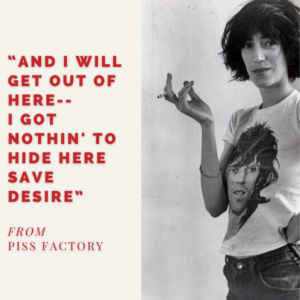 Punk is as much of a social movement as it is a form of music. It’s not just heavy instrumentals and loud vocals. What separates punk from its “rowdy” predecessors is its stance against inequality.
Punk is as much of a social movement as it is a form of music. It’s not just heavy instrumentals and loud vocals. What separates punk from its “rowdy” predecessors is its stance against inequality.
“Piss Factory” was like nothing ever heard before. It was loud and brash. The song wasn’t designed to be “fun”, “romantic”, or “groovy”. Laden with expletives and call out, it was there to create controversy.
And this has defined punk ever since: Punk music isn’t a specific sound. It’s a disruption.
“Piss Factory” was a musical history disruption…and more so? People loved it.
It might sound surprising today, but it was through Bob Dylan’s influence that the Patti Smith Group signed their first record deal with Arista Records (Horses, 1975, with cover art by Mapplethrope).
The opening song on the album, “Gloria: In Excelsis Deo” is the perfect homage to everything Smith worked towards: “Jesus died for somebody’s sins, but not mine.”
Debbie Harry: More Than Just a Blondie
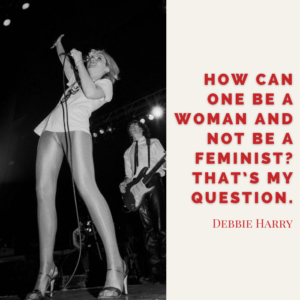 “Unfortunately for me, or unfortunately for my parents, I was determined to be an artist,” says Debbie Harry in an interview with MOJO magazine.
“Unfortunately for me, or unfortunately for my parents, I was determined to be an artist,” says Debbie Harry in an interview with MOJO magazine.
And Harry’s determination helped her achieve her goal. Today, everyone’s familiar with her band, Blondie.
Don’t tell me you don’t secretly rock out to Call Me. It’s okay, we all do.
But where did this influential singer get her start?
At three months old, she was adopted by Richard and Catherine Harry, two gift shop owners in New Jersey. The couple loved her…but making a living as an artist? Well, let’s just say parents of the 1950s and 60s had very similar opinions about a proper vocation as they do today.
Still, she pursued her dreams.
Harry began as a backup singer for a folk group in late 1960 before offering her vocal skills to a band called The Stilettos. It was during her time performing with The Stilettos she met the man of her dreams: Chris Stein.
The two became longtime lovers and left the band in pursuit of their work. And this is how Debbie Harry became a punk icon…
From CBGB to Success
Opening in 1973 in the Bowery of NYC, CBGB carried a reputation as one of the sketchiest music clubs in New York City.
That means it was the place to play if you had an up-and-coming punk band.
The name CBGB stood for “Country Bluegrass Blues,” but the venue is now known for its punk band startups: The Ramones, The Misfits, Talking Heads, Television, and The Cramps.
It was in this scene Debbie Harry debutes The Angel and the Snake (later renamed to Blondie). The female fronted band’s performance was second only to Patti Smith, who had played with her group a year prior.
The Angel and the Snake spent the summer of 1975 playing at CBGB’s. Harry hated playing at the bar, remarking on how bad it smelled and how terrible the conditions were. But these performances boosted their popularity, and brought them into the spotlight.
In 1976, the band changed their name. The new name, Blondie, came from catcalls that Harry heard directed at her by truckers in NYC. There’s a power in reclamation, she believed, and she capitalized on it for success. The tongue in cheek name change would be the start of Harry’s punk attitude.
In December that year, the band released their self-titled debut album.
Critic’s Initial Reaction to the Album
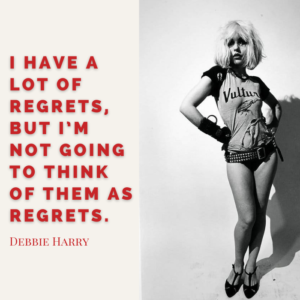 Today, Blondie has sold over 40 million records worldwide and is viewed as a major success.
Today, Blondie has sold over 40 million records worldwide and is viewed as a major success.
But at the time?
Blondie’s album was regarded as just one of many New York punk bands. The punk scene was new- and the public wasn’t sold on this loud style of performance.
At the time the Sex Pistols, the most recognized punk band, had a reputation for mistreating venues, rampant hard drug use, self mutilation, and even animal abuse. The band’s popularity and celebrity status was a slap in the face to American punk bands.
“If every punk band was like the Sex Pistols,” the thought was, “why would anyone want to be involved?”
Blondie’s ties to the “punk” label at the time stunted their debut album’s success.
Strangely enough, today both critics and fans argue Debbie Harry’s music wasn’t actually punk at all.
The Great Genre Debate: Pop, Punk, or New Wave?
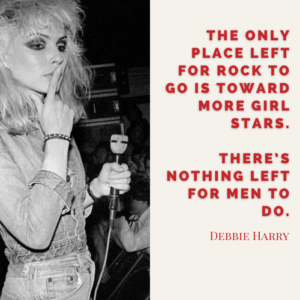 When Blondie’s first album dropped, Rolling Stone Magazine said, “In their self-consciousness and liberal open-mindedness, these bands are as punky as Fonzie: that is, not at all.”
When Blondie’s first album dropped, Rolling Stone Magazine said, “In their self-consciousness and liberal open-mindedness, these bands are as punky as Fonzie: that is, not at all.”
Even now, dozens of respected op-eds declare Blondie a “girly pop band,” and “absurd to call punk.”
But here’s the irony: These same punk enthusiasts will call The Talking Heads and Devo punk without missing a beat.
What gives?
While today new wave is defined by the heavy use of synth whereas punk is recognizable by its grunge-heavy guitar, up until the decade, the genre titles of “punk” and “new wave” went hand in hand.
At the time, new wave referred to “radio friendly” bands with heavy punk influences. In fact, radio stations and venues started using the label specifically for marketing: new wave was less risky- and had the potential to sell more.
Debbie Harry’s music is no different from other new wave and punk bands at the time.
So why was it labeled by reviewers, to the detriment of the release, as punk?
The answer: Because she was a woman.
It was just too much for a woman to be considered both a widely appealing artist and…angry.
And the Truth is: Harry was Angry.
Her playful voice and feminine charm can cast a doubt on the intentionality of her work, but a read of her lyrics shows an artist who, at the heart of her work, wrote angry songs describing the world around her.
Take Blondie’s song “Rip Her to Shreds”, where fast tempo and cutting words don’t leave room for doubt:
“Oh, you know her, “Miss Groupie Supreme”/ Yeah, you know her, “Vera Vogue” on parade/ Red eye shadow! Green mascara! /Yuck! She’s too much”.
“Rip Her to Shreds” is Debbie Harry’s callout of media mistreatment of female-fronted bands. She highlights how her own band faced additional critique from its male-fronted comparisons, and was often dismissed as nothing more than a bunch of groupies.
“Rip Her to Shreds” is a call out of every douchey dude on the music scene that tells a woman she just ‘doesn’t get it.”
And to the critics who now think Blondie doesn’t have a place in annals of punk history? Bite it. Harry paid her dues- and then some- in the fight for women’s equality in the music industry.
Poly Styrene: Anti-Consumerist
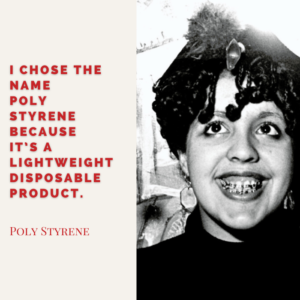 Ever heard of the band X-Ray Spex?
Ever heard of the band X-Ray Spex?
Maybe not.
What about Bikini Kill? Or Sonic Youth? Or even Henry Rollins?
Odds are, even if you don’t know their music, you’ve at least heard these names. And they all owe their influence to Poly Styrene and her band, X-Ray Spex.
Styrene was born in 1957, named Marianne Joan Elliot-Said. She was the daughter of an English mother and Somalian father- and her life as a POC played a huge role in her musical career.
Her daughter, Celeste Bell, helped co-write Dayglo, a biography on Styrene.
In an interview with Forbes, Bell talks about her mother’s struggle with identity, saying, “She was constantly searching for a sense of belonging in a world where she had always felt an outsider. My mother struggled more than most in her brief life; she struggled with mental illness, physical and sexual abuse, racism and poverty – yet it was these difficulties at a young age that formed Poly Styrene and gave her such a unique perspective.”
After seeing The Sex Pistols perform in 1976, Styrene chose her new stage name out of the Yellow Pages and put out ads looking for other band mates. From there, X-Ray Spex was born.
Styrene rocked lead vocals with Jak Airport on guitar, Paul Dean on bass, Paul Hurding on drums, and Lora Logic on the Saxophone.
Instant Success in the London Scene
cicites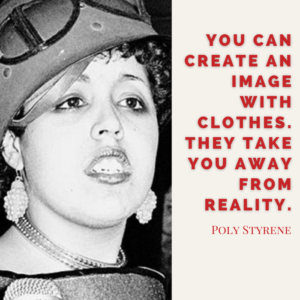 In 1977, after only 6 rehearsals, X-Ray Spex played their debut performance at London’s Roxy Theatre.
In 1977, after only 6 rehearsals, X-Ray Spex played their debut performance at London’s Roxy Theatre.
Styrene’s powerful vocals, the band’s unconventional look, and their upbeat music made them an instant success. X-Ray Spex played at the Roxy twice within their first 100 days of forming. After which, they went on to perform with The Buzzcocks, Wire, and Johnny Moped.
If I could go back in time and see any performance, this show would be high on my list. I can only imagine seeing both X-Ray Spex and the Buzzcocks share a stage.
On their second night at the Roxy, the band debuted one of their most popular songs, “Oh Bondage Up Yours.”
This song is pivotal in the band’s success but became a monumental turning point for women in punk history. Kathleen Hanna (Bikini Kill) cites the song as a critical influence in the Riot Grrrl movement.
“If her work wasn’t there, I’m not positive Riot Grrrl would exist.”
A year after their performance at the Roxy, the band released Germ Free Adolescents- a fast and furious upbeat work featuring saxophone on every track. Unlike other female-fronted bands at the time, the X-Ray Spex broke through the glass ceiling of punk.
At the height of their success, X-Ray Spex only put out one album and five singles.
Touring took its toll on 18-year-old leading vocalist Poly Styrene. In 1979, she took a break- reforming it again over a decade later in 1991 and 1995.
In the 1990s, they released their second and final album, Conscious Consumer. True to punk’s cause-driven definition, the album was a stance against capitalism and consumerism.
Anti-Fast Fashion, Pro-Individuality
In recent years, we’ve seen a resurgence of the stance against fast fashion. The fashion industry is responsible for 8% of the world’s total carbon output. Those who understand its impact agree the emphasis on reusing and thrifting clothes is more important than ever.
One of the biggest names in the fight against this form of wasteful consumerism? Poly Styrene.
Styrene always had a fascination with fashion. Before embarking on the music scene, she owned and ran her own store, selling thrifted clothes and handmade jewelry in her early to mid teens. She used clothing as a form of expression and to solidify her individuality in a scene that often sought to stereotype her.
In many performances, Styrene is spotted wearing pastels, crazy headbands, and gimmicky earrings.
Her interest in fashion, her place as a biracial artist, and her youth became part of her identity. She was never ashamed of her braces or natural curls. Even after having her braces removed, Styrene at times sported a fake set as an homage to that early point in her musical career.
This theme of anti-consumerism is apparent throughout the band’s discography.
Take “Oh Bondage Up Yours”.
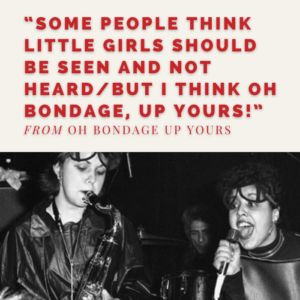 Upon initial release, the song was perceived as an ode to S&M. After all, just look at the title. But Styrene says the song carries more meaning than that- that it’s about breaking free from the chains of the material world.
Upon initial release, the song was perceived as an ode to S&M. After all, just look at the title. But Styrene says the song carries more meaning than that- that it’s about breaking free from the chains of the material world.
This theme is apparent in lines like:
Chain-store, chain-smoke/ I consume you all/ Chain-gang, chain-mail/ I don’t think at all.
And although the message can be misconstrued, when you keep the theme in mind, it’s apparent in every verse. Consumerism is all consuming, not even requiring more than a second thought. It’s a bondage to capitalism.
Styrene made a massive impact in both the punk scene, and the world around her.
These important causes, both against fast fashion and the fight for gender equality, are battles we still fight today. Styrene revolutionized the white male dominated punk scene- and we owe some of the greatest female-fronted bands in history to her influences.
Redefining Women in Music
“I started listening to Blondie,” my ten-year-old sister announces over dinner.
The kids at school have nicknamed her blondie. She grins as she lets me in on the little secret only she and I understand.
In this music, she found the same reclamation that Debbie Harry did over fifty years before.
And that’s the power of music, but more so, the power of punk. These artists carved a place in a world that wasn’t designed for women. Through grit, determination, and perseverance, they made room for girls like me…and my sister.
Like Patti, Debbie, and Poly, we were little girls with too much to say. Little blondies who wanted a place for our voice.
Revolutionizing Multiple Genres
These punk queens redefined multiple music genres, cleared the path for causes like anti-fast fashion and feminism, and gave foothold to the musical drive behind the most popular bands today.
History is filled with examples of revolutionary women. Chavela Vargas’ style completely redefined Ranchera music. Harpist Dorothy Ashby’s music put other jazz musicians to shame.
Women continue to lead the way in the music industry. Let’s look at what other musicians have to say on our punk queens’s influences.
Take this quote from Johnny Marr of the Smiths about Patti Smith:
“She has always put out the vibe that art and rock’n’roll are in the same place if you want it and know where to look. She was making connections between Rimbaud and Jean Genet and Ginsberg and Burroughs and rock’n’roll and seemed really to live it, which was great to be turned on to as a fan.”
In an interview with The New York Times, Hayley Williams of Paramore names Blondie as inspiration for her songwriting. Williams attributes her song, “Dreaming” to Blondie, saying:
“Every day in the car it was like, why can’t I play “Heart of Glass”? We finally wrote a song called “Daydreaming,” which is a total rip of “Dreaming” by Blondie, because I couldn’t think of a better title.“
British folk rock artist Billy Bragg called Poly Styrene’s lyrics “a slap in the face to male punk bands and rock journalists.”
The point is: these punk women didn’t just make room in their own genre, they redefined music for generations.

